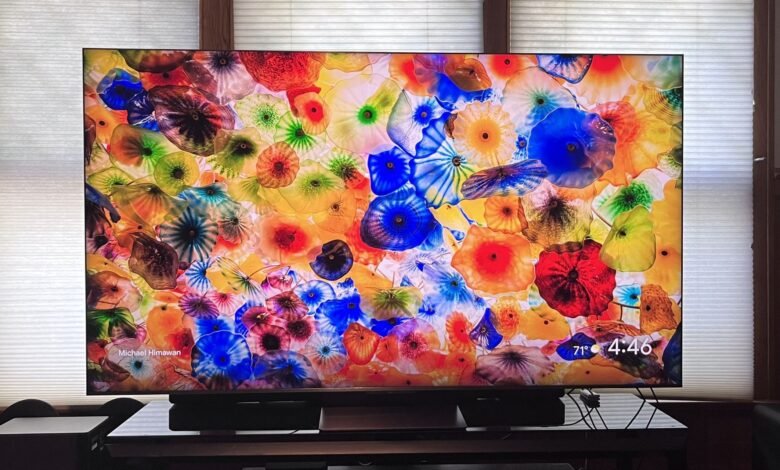TCL QM9K Review: Brilliant Mini-LED TV with Gemini AI

▼ Summary
– The TCL QM9K is TCL’s 2025 flagship mini-LED TV featuring exceptional brightness, rich color, strong contrast, an anti-reflection screen, and an ultra-wide viewing angle.
– It includes Google TV enhanced with Gemini AI for advanced voice-based content searches, contextual conversations, and image generation, with queries deleted after 10 minutes for privacy.
– The TV has an Audio by Bang & Olufsen speaker system with Dolby Atmos support and is one of the first to support Dolby FlexConnect for wireless sound with compatible speakers.
– Gaming features include two HDMI 2.1 ports with 4K 144Hz support, FreeSync Premium Pro, ALLM, and a Game Accelerator 288 for 288Hz gaming at 1080p resolution.
– Priced higher than competitors like the Samsung QN90F and TCL QM8K, the QM9K offers exclusive features like a built-in presence sensor but faces strong competition in the flagship mini-LED TV market.
The TCL QM9K emerges as a standout flagship mini-LED television for 2025, delivering an exceptionally bright and vibrant picture complemented by rich colors and powerful contrast. Its anti-reflection screen and ultra-wide viewing angle enhance the viewing experience, while the integrated Audio by Bang & Olufsen system provides muscular Dolby Atmos sound. This model also supports the innovative Dolby FlexConnect wireless audio format and distinguishes itself as the first Google TV enhanced by Gemini AI, taking content discovery and smart interaction to new heights.
As the final TV series TCL introduced in 2025, the QM9K clearly represents the pinnacle of the company’s offerings. Packed with top-tier performance and exclusive features, it stands out in the competitive mini-LED market. A key exclusive at launch is Google TV with Gemini, which integrates the Gemini AI chatbot into the familiar Google TV interface. This allows for not only content searches but also research on virtually any topic, from cooking recipes to historical subjects, using the television’s built-in far-field microphone.
Gemini supports contextual, conversational interactions, letting you ask follow-up questions without losing track. For privacy-conscious users, queries are automatically deleted after ten minutes. Additional Gemini capabilities include generating images, and with the TV’s built-in presence sensor, another QM9K exclusive, your custom-created screensavers can appear automatically when you enter the room.
Picture quality is driven by a mini-LED panel featuring up to 6,500 local dimming zones and TCL’s Halo Control System, which significantly reduces backlight blooming. The result is a brilliantly bright image with deep, uniform blacks and detailed shadows. Other enhancements include an AIPQ Pro processor, wide viewing angle technology, and an anti-reflective screen. The set supports Dolby Vision IQ and HDR10+ high dynamic range formats, and it is both IMAX Enhanced and equipped with Filmmaker Mode.
The Audio by Bang & Olufsen speaker system delivers potent Dolby Atmos sound with clear dialogue and impressive bass for a television. For those seeking even better audio, the QM9K is among the first TVs to support Dolby FlexConnect, enabling wireless Atmos output to compatible Z100 speakers and a Z100-SW subwoofer, with automatic system configuration for optimal performance.
TCL’s Zero Bezel design reduces the bezel width to just 3.2mm, creating a striking “all-picture” appearance. An adjustable height pedestal stand offers solid support and can accommodate a soundbar, while the TV’s tapered edges contribute to a slim profile.
Gaming features are respectable, with two HDMI 2.1 ports supporting 4K at 144Hz, FreeSync Premium Pro, ALLM, and Dolby Vision gaming. A pop-up Game Bar allows quick adjustments, and the Game Accelerator 288 feature enables 288Hz gaming at 1080p resolution.
The QM9K is available in screen sizes from 65 to 98 inches. As TCL’s flagship, it carries a premium price, though prices have already begun to drop since launch. The 75-inch model reviewed here launched at $3,499 but has since been reduced to $2,499. Competing 75-inch flagship mini-LED models include the Samsung QN90F, currently around $2,099, and the Hisense U8QG, selling for approximately $1,899.
Key specifications include a QLED mini-LED screen, a 144Hz refresh rate, support for Dolby Vision, HDR10+, HDR10, and HLG, Dolby Atmos audio, Google TV with Gemini, four HDMI ports (two HDMI 2.1), and an ATSC 3.0 tuner.
The high-contrast display panel benefits from a wide viewing angle and anti-reflective screen. The Halo Control System, with a 23-bit controller and dynamic light algorithm, minimizes blooming from the mini-LED backlight. The AIPQ Pro processor handles upscaling and noise reduction. High dynamic range support covers both Dolby Vision IQ and HDR10+, and the set is IMAX Enhanced with a Filmmaker Mode preset new to TCL TVs in 2025.
The built-in Audio by Bang & Olufsen system includes upfiring speakers for Atmos height effects and dual subwoofers on the rear panel. DTS:X pass-through is supported. The Zero Border design creates an almost invisible bezel, maximizing the screen area. A built-in presence sensor can turn the TV on and switch to ambient mode when you enter the room. Voice commands are supported via the built-in far-field mic or the backlit remote.
Gemini AI allows contextual, voice-based content searches and can control Google Assistant smart home devices. The TV also works with Alexa and Apple HomeKit and includes built-in AirPlay and Chromecast support.
Gaming is supported with 4K 144Hz on two HDMI ports, FreeSync Pro, and Game Accelerator 288 for 1080p gaming at 288Hz. An onscreen Game Bar lets you adjust settings without exiting your game.
In testing, the QM9K proved exceptionally bright, with measured peak HDR brightness reaching 3,322 nits in Filmmaker Mode and 3,811 nits in Standard mode. Fullscreen HDR brightness was around 660 nits in both modes. Color gamut coverage was excellent at 96.7% for UHDA-P3 and 79.7% for BT.2020. Color accuracy was strong, with an average Delta-E of 1.8, and grayscale accuracy averaged 2.8.
The combination of high brightness, accurate color, and refined local dimming produced a stunning picture. Watching Spider-Man: Into the Spider-Verse on 4K Blu-ray revealed powerful contrast and a vibrant, psychedelic color palette. Animated textures displayed impressive detail, creating a near-3D effect. Streaming Ripley in 4K Dolby Vision from Netflix showed clear textures in clothing and objects, with uniform black and white images and subtle gray tones easily discernible.
Test patterns confirmed the effectiveness of the CrystGlow WHVA Panel in maintaining uniform color and contrast across wide viewing angles. The Halo Control System excelled at minimizing backlight blooming in high-contrast images.
Motion handling showed some judder, adjustable via the Custom mode in the Motion menu without introducing excessive soap opera effect. A slight degree of vignetting at the screen edges, likely due to the Zero Border design, was mostly visible on test patterns and rarely noticeable during normal viewing. The anti-reflection screen effectively reduced glare from overhead lights, though some reflections from lamps directly in the screen’s path were visible, particularly with dark images.
The Audio by Bang & Olufsen system includes upfiring drivers and built-in subwoofers. Dolby FlexConnect compatibility allows use with wireless Z100 speakers and a Z100-SW subwoofer, with automatic configuration and flexible speaker placement. The Beosonic interface, available in the Custom sound preset, lets you adjust sound characteristics using a cursor moving between Relaxed, Energetic, Bright, and Warm quadrants.
Overall sound quality is potent, with clear dialogue and satisfying bass. In the chase scene from No Time to Die, crashes and gunfire had good impact and directionality, and Atmos height effects were notably strong. While many will find the built-in speakers sufficient, adding a soundbar or using FlexConnect can match the outstanding picture quality.
The Zero Border design minimizes the bezel to 3.2mm for an all-picture look. The panel is two inches deep with tapered sides for a slimmer profile. The metal pedestal stand has two height positions, with the higher setting clearing space for a soundbar. Connections include four HDMI ports (one with eARC), two USB Type-A, Ethernet, and an optical digital audio output, plus an ATSC 3.0 tuner input.
The full-size backlit remote has an uncluttered layout with direct access buttons for Netflix, Prime Video, and YouTube, an input select button, and a Free TV button for ad-supported streaming channels.
The QM9K is the first Google TV with Gemini AI, allowing conversational interactions using the built-in far-field mic or the remote’s mic. Gemini enables detailed content searches, general research, news briefs with video links, and image generation for screensavers. The built-in presence sensor can activate AI-generated screensavers or a Google Photos gallery when you enter the room.
A Live TV portal provides a grid guide for ATSC 3.0 broadcasts, including NextGen channels, alongside Google TV Freeplay and TCL’s free ad-supported channels, sortable by genre or antenna-only. AirPlay and Chromecast are built-in, and the TV works with Alexa, Google Assistant, and Apple HomeKit.
Extensive settings cater to picture and sound tweakers, with multiple gamma and contrast adjustments in the Brightness menu and various audio presets, including the custom Beosonic adjustment. Settings are accessible via the gear icon on the remote or home screen, or through a quick menu at the screen’s bottom.
Gaming features include two HDMI 2.1 ports with 4K 144Hz support, FreeSync Premium Pro, ALLM, Dolby Vision gaming, Game Accelerator 288 for 1080p at 288Hz, and a Game Bar overlay. The bright, contrast-rich picture makes games look fantastic, and input lag measured 12.9ms, ensuring responsive performance.
The TCL QM9K is a fantastic TV, though its value is moderated by strong mini-LED competition in 2025. The 75-inch model has been reduced to $2,499, but competitors like the Samsung QN90F are available for $2,099. The QM9K offers higher peak HDR brightness than the Samsung and Hisense U8QG, but the Samsung has superior gaming features and performance. TCL’s step-down QM8K also delivers impressive picture quality with similar features like the Zero Border screen, ultra-wide viewing angle, and anti-reflective screen.
Google TV with Gemini, currently exclusive to the QM9K, enhances its value, though this feature is expected to come to the QM8K and Hisense U8QG later in 2025. The QM9K remains the only model with a built-in presence sensor.
Consider the TCL QM9K if you watch in bright rooms, prefer not to use a soundbar, or want sophisticated AI features. Look elsewhere if you want to save money or have privacy concerns about AI, though queries are deleted after ten minutes.
Alternatives include the Samsung QN90F, with superior gaming and anti-reflection screen but no Gemini; the TCL QM8K, a step-down model with bright picture and refined local dimming, slated to receive Gemini; and the Hisense U8QG, with exceptional brightness and planned Gemini update, though weaker off-angle picture and built-in speakers.
Testing involved approximately 15 hours of measurement and evaluation using Calman color calibration software. After casual viewing to assess out-of-the-box presets, the most accurate preset was selected and calibrated for grayscale and color accuracy. Measurements included peak light output for HDR using 10% and 100% white window patterns, and coverage of DCI-P3 and BT.2020 color space. Reference scenes from 4K Blu-ray discs and streamed 4K HDR content were used for subjective evaluation.
(Source: TechRadar)


